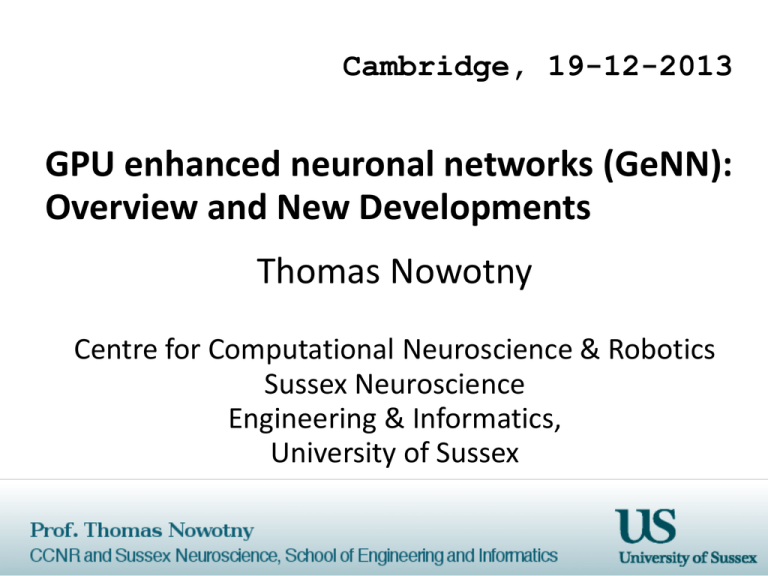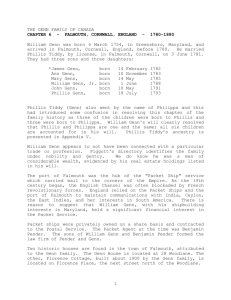GeNN
advertisement

Cambridge, 19-12-2013
GPU enhanced neuronal networks (GeNN):
Overview and New Developments
Thomas Nowotny
Centre for Computational Neuroscience & Robotics
Sussex Neuroscience
Engineering & Informatics,
University of Sussex
Part I
GENN OVERVIEW
Introduction
Fuelled by the games industry,
graphics adaptors have become
very powerful and are now
using massively parallel
graphical processing units
(GPUs)
They offer a new platform for
HPC
NVIDIA® TESLA C2050,
(Image from NVIDIA
product website)
From: Herb Sutter, “The Free Lunch Is Over: A
Fundamental Turn Toward Concurrency in
Software”
NVIDIA® CUDATM
CUDATM= “Common Unified Device Architecture”
Was introduced by NVIDIA® to allow main stream
developers to use massively parallel graphics chips for
GPGPU without the restrictions of shaders
The first CUDA SDK was released Feb 2007 (according
to Wikipedia)
CUDATM is supported on all newer NVIDIA cards
The CUDATM API
Each thread executes what is called a “kernel”, defined
by a C-like function
CUDA is a Single-Instruction-Multiple-Data (SIMD)
environment
Communication between threads is through shared
memory spaces
dV
= -V ...
dt
Block 1
Block 2
Model
n2
Block 3
Grid 1
n1
Block 4
Isyn= …
Synapse Blocks
Grid 2
nsyn
Issues to consider
Correct parallelization
Code structure
Synchronization
Atomics (no synchronization between blocks!)
Block size, number & alignment
(unrolling) loops
Memory access patterns
Use of different memories
Memory bank access conflicts
Coalesced memory access
Host to/from GPU data transfers
CUDA memory architecture
“Local Memory”
Device memory
Constant memory
Texture memory
Shared memory
GPU registers
Graphics adaptor
Random Access
Memory (RAM)
Cache/Registers
Host computer
Program /
CPU
Kernel /
GPU
GPU Neural Network Simulators
Nageswaran et al. (UC Irvine, 2009): General simulator for
Izhikevich neurons with delay, optimized for Izhikevich's thalamocortical model (C++ library)
Fidjeland et al. (Imperial, 2010) - Nemo: General simulator for
Izhikevich neurons with delay, optimized for Izhikevich's thalamocortical model (C++ library)
Goodman & Brette (Ecole Normale Sup., 2009): GPU extensions to
the Brian simulator (one-timestep grids with partial CPU
involvement)
Mutch et al. (MIT, 2010) CNS simulator: Simulator for layered
“cortical networks”, models can be defined by the user (used
exclusively through a MatLab interface)
GeNN: Taking code generation seriously
The GPU enhanced Neuronal Network simulator
Provides a simple C++ API for specifying a neuronal network of
interest
Generates optimised C++ and CUDA code for the model and for the
detected hardware at compile time (e.g. grid/block organisation, HW
capability, model parameters)
GeNN can offer a large variety of different models – only the used
ones actually enter the generated code
Users can define their own model equa
The generated code is compiled with the native NVIDIA compiler
nvcc (and all its optimisations).
GeNN flowchart
Example: Insect olfaction model
Performance
GPU
AL-MB:
50 % all-to-all
Individual
conductances
CPU
spikes communicated to host
(dotted)
spike #
communicated to host
(solid)
Examples of code-gen benefits
Synaptic connectivities:
GeNN
model.addSynapsePopulation("PNKC", NSYNAPSE, DENSE,
INDIVIDUALG, "PN", "KC", myPNKC_p);
model.addSynapsePopulation("PNLHI", NSYNAPSE,
ALLTOALL, INDIVIDUALG, "PN", "LHI", myPNLHI_p);
model.addSynapsePopulation("LHIKC", NGRADSYNAPSE,
SPARSE, INDIVIDUALG, "LHI", "KC", myLHIKC_p);
Each connectivity type can generate entirely different code:
DENSE
SPARSE
Post
gsyn
ID
nsynapse
connectivity matrix
npre-neuron
npost-neuron
npre-neuron
Pre
#
sparse
matrix
representation
Examples of code-gen benefits
New neuron models:
GeNN
int newModel= nModels.size();
n.varNames.push_back(tS("V"));
n.varTypes.push_back(tS("double"));
n.pNames.push_back(tS("tau"));
n.simCode= tS(“$(V) = $(V) + DT/ $(tau)* (- 40.0*$(V))");
nModels.push_back(n);
GeNN
model.addNeuronPopulation("gp", 1000, newModel, p, ini);
Part II
NEW DEVELOPMENTS
SpineML
Courtesy of Dr. Alex Cope
SpineML is an XML-based description format for
networks of point neurons
It is a proposed extension of the NineML format,
including the description of neural dynamics, network
structure, and experimental procedures.
SpineML acts as an exchange format between creation
tools and simulators, as well as between collaborators
working on a shared model
For more details see:
Richmond P, Cope A, Gurney K, Allerton DJ. "From Model Specification to Simulation of
Biologically Constrained Networks of Spiking Neurons" Neuroinformatics. 2013
SpineCreator
SpineCreator is one tool that can be used to author
SpineML models
A Graphical User Interface allows models to be
specified without any programming
Some features:
Graphing
3d visualisation
Extensible simulator support
Version control support
Available at https://github.com/SpineML/SpineCreator
Courtesy of Dr. Alex Cope
SpineML and GeNN
Courtesy of Dr. Alex Cope
SpineML can use code generation for simulator support, so it is very easy to add support for
GeNN
XSLT translation scripts transform the model into GeNN user files, and the GeNN standard
toolchain compiles and runs the simulation
Support for new neuron types (and soon synapses and weight update rules) is supported
through XSLT translation to GeNN system files
BRIAN2 interface
BRIAN is a popular simulator for neuronal networks
(http://briansimulator.org/)
BRIAN2 is in active development and will be entirely codegeneration based
Users will be able to choose target devices,
including Python (as before), C/C++, Android and
GPU/GeNN
Proof of concept
BRIAN2
from brian2 import *
from brian2.devices.genn import *
set_device('genn');
##### Define the model
tau = 10*msecond
eqs = '’’dV/dt = (-40*mV-V)/tau : volt # (unless-refractory)'''
threshold = 'V>-50*mV'
reset = 'V=-60*mV'
refractory = 5*msecond
N = 1000
##### Generate genn code
G = NeuronGroup(N, eqs, reset=reset, threshold=threshold, name='gp')
M = SpikeMonitor(G)
G2 = NeuronGroup(1, eqs, reset=reset, threshold=threshold, name='gp2')
# Run the network for 0 seconds to generate the code
net = Network(G, M, G2)
net.run(0*second)
genn_device.build(net)
GeNN
// setp 1: add variables
n.varNames.clear();
n.varTypes.clear();
n.varNames.push_back(tS("V"));
n.varTypes.push_back(tS("double"));
n.varNames.push_back(tS("lastspike"));
n.varTypes.push_back(tS("double"));
n.varNames.push_back(tS("not_refractory"));
n.varTypes.push_back(tS("bool"));
// step2: add parameters
n.pNames.clear();
n.pNames.push_back(tS("tau"));
n.pNames.push_back(tS("mV"));
// step 3: add simcode
n.simCode= tS(" $(not_refractory) = ($(not_refractory)) || (!(false));\n\
const double _V = $(V) * exp(-(DT) / $(tau)) - 40.0 * $(mV) + 40.0 * $(mV) * exp((DT) / $(tau));\n\
$(V) = _V;\n\
");
// step 4: add thresholder code
n.thresholdCode= tS(" const double _cond = $(V) > -50 * $(mV);\n\”
);
// step 5: add resetter code
n.resetCode= tS(" \n\
$(V) = -60 * $(mV);\n\
");
nModels.push_back(n);
from brian2 import *
from brian2.devices.genn import *
set_device('genn');
##### Define the model
tau = 10*msecond
eqs = '’’dV/dt = (-40*mV-V)/tau : volt # (unless-refractory)'''
threshold = 'V>-50*mV'
reset = 'V=-60*mV'
refractory = 5*msecond
N = 1000
##### Generate genn code
G = NeuronGroup(N, eqs, reset=reset, threshold=threshold, name='gp')
M = SpikeMonitor(G)
G2 = NeuronGroup(1, eqs, reset=reset, threshold=threshold, name='gp2')
# Run the network for 0 seconds to generate the code
net = Network(G, M, G2)
net.run(0*second)
genn_device.build(net)
BRIAN2
// setp 1: add variables
n.varNames.clear();
n.varTypes.clear();
n.varNames.push_back(tS("V"));
n.varTypes.push_back(tS("double"));
n.varNames.push_back(tS("lastspike"));
n.varTypes.push_back(tS("double"));
n.varNames.push_back(tS("not_refractory"));
n.varTypes.push_back(tS("bool"));
// step2: add parameters
n.pNames.clear();
n.pNames.push_back(tS("tau"));
n.pNames.push_back(tS("mV"));
// step 3: add simcode
n.simCode= tS(" $(not_refractory) = ($(not_refractory)) || (!(false));\n\
const double _V = $(V) * exp(-(DT) / $(tau)) - 40.0 * $(mV) + 40.0 * $(mV)
* exp(-(DT) / $(tau));\n\
$(V) = _V;\n\
");
// step 4: add thresholder code
n.thresholdCode= tS(" const double _cond = $(V) > -50 * $(mV);\n\”
);
// step 5: add resetter code
n.resetCode= tS(" \n\
$(V) = -60 * $(mV);\n\
");
nModels.push_back(n);
GeNN
Summary
GeNN is a code-generation based simulator targeting
GPUs with NVIDIA CUDA.
The native C/C++ interface is flexible and convenient for
expert users.
A SpineCreator – SpineML – GeNN pipeline has been
prototyped and will be used in the Green Brain project.
A BRIAN2 – GeNN interface is in development and will
hopefully be released with 1st release of BRIAN2.
Acknowledgments
Ramon Huerta, Alex Cope, Esin Yavuz, James Turner
NVIDIA (professor partnership: 2x Quadro FX 5800
cards) & hardware donation for Green Brain
Funders:
http://www.sourceforge.net/projects/genn










